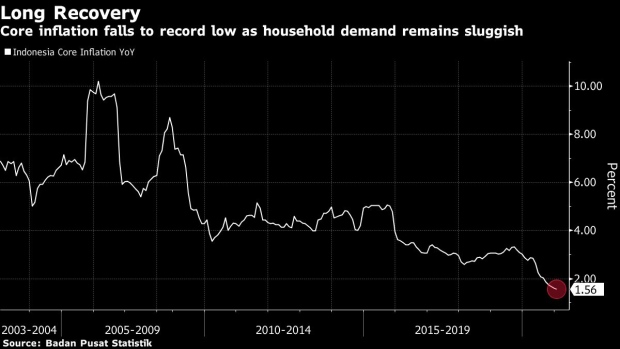Feb 4, 2021
Southeast Asia’s Worst Virus Outbreak Hammers Indonesia Economy
, Bloomberg News

(Bloomberg) -- Indonesia’s economy capped its first annual contraction since the 1998 Asian financial crisis as the region’s worst coronavirus outbreak continued to sap activity through the fourth quarter.
Gross domestic product in the final three months of 2020 fell by 2.19% from a year earlier, the statistics bureau said Friday. The median estimate in a Bloomberg survey was for a contraction of 2.3%. For the full year, GDP slipped 2.07%, in line with a 2.1% drop economists forecast.
Southeast Asia’s largest economy has struggled to find a clear path out of recession, as looser curbs on movement during much of the fourth quarter hastened the virus spread yet failed to spur private consumption. Covid-19 infections and deaths continued to rise by record numbers in January, prompting more stringent anti-virus measures and raising doubts about whether Indonesia could return to growth this quarter.
Key Insights
- Private consumption, which accounts for roughly 60% of Indonesia’s GDP, will be key to any rebound. Latest economic indicators point to still-tepid demand, with core inflation notching a historic low in January. Retail sales continue to fall while consumers remain pessimistic
- Trade and investment can give the economy a reprieve. Higher commodity prices and stronger overseas demand drove exports to a better-than-expected performance in December, while factory activity continues to expand
- The government has scaled up stimulus as it looks to achieve 5% GDP growth this year. It raised the budget to 619 trillion rupiah ($44 billion), 66% more than its initial estimate, which will fund tax breaks, cash subsidies and free vaccines, among other items
Get More
- Bank Indonesia has pledged to keep monetary policy loose, saying it sees no “immediate concern” of inflation. Governor Perry Warjiyo said in January that monetary authorities have room to cut interest rates further and are weighing further action
- Indonesia’s Financial System Stability Committee is working on a policy package that aims to overcome the credit crunch and lift bank lending to businesses. Credit growth fell 2.4% in 2020 despite liquidity injections from the central bank and the government’s credit-guarantee program
- The economy shrank 0.42% from the previous quarter on a non-seasonally adjusted basis, worse than the 0.22% drop forecast by economists.
©2021 Bloomberg L.P.


